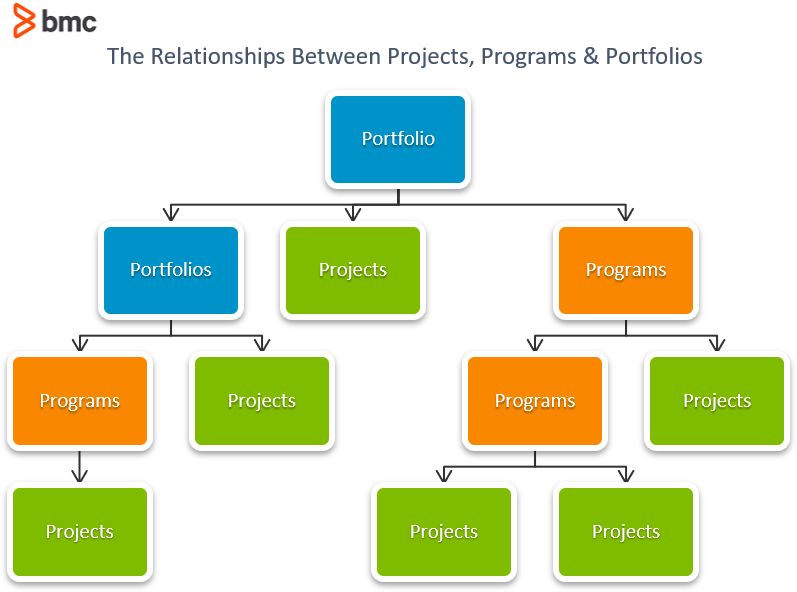Project Management, Program Management, and Project Portfolio Management are interrelated disciplines of the Project Management Body of Knowledge (PMBOK) published by the Project Management Institute (PMI).
To understand each management discipline, you first need to understand:
- PMI projects, programs, and portfolios
- What each discipline does
- How they support each other
- How they differ from each other
- Certification requirements for each discipline
Let’s get started.
Defining project vs program vs portfolio
According to PMBOK:
A project is “…a temporary endeavor undertaken to create a unique product, service, or result.”
Projects have a defined scope. They have a definite beginning and end. They are initiated in response to either:
- A need, request, or requirement that must be fulfilled
- A product, process, or service that must be created
Projects enable business value. A project can be a stand-alone initiative or part of a larger program or portfolio.
A program is a group of related projects and subsidiary programs that are managed in a coordinated way to realize benefits that cannot be achieved separately.
Importantly, programs are not large projects. Instead, programs involve coordinating and managing their related projects and sub-programs to ensure the promised delivery and benefits of the entire program.
A portfolio encompasses a group of projects and/or programs that are managed as a group to achieve strategic and financial objectives.
Portfolio items are grouped together to ensure the effective governance and management of project and program work to meet organizational priorities and strategies.
The relationship between projects, programs, and portfolios is shown here:

(Source)
To better illustrate the difference between projects, programs, and portfolios, imagine that your organization has a project that involves creating a new case for a laptop computer.
That case project could be part of a program to assemble a new laptop that encompasses other projects for creating the motherboard, the CPU, and all other laptop component projects. The laptop assembly program and other related programs and projects might be part of a portfolio containing all laptops that your organization has built and sold.
Putting it more simply, note these relationships, per the above chart:
- Programs can encompass one or more projects.
- Portfolios can encompass several programs and projects.
Every project component is supported by and supports the other two components.
Defining project management, program management & project portfolio management…the right way
Project management, program management, and project portfolio management are fundamentally different. PMI plainly spelled it out in the sixth edition PMBOK guide when it wrote:
Program and project management focus on doing programs and projects the “right” way; and portfolio management focuses on doing the “right” programs and projects.
Project management and program management enable business value through the creation and delivery of a unique product, service, or result. They involve execution and results delivery. Projects and programs are generally carried out by project managers or program managers.
What’s project portfolio management?
On the other hand, project portfolio management (PPM) is the centralized management of one or more project portfolios to achieve strategic objectives. PPM involves:
- Business analysis
- Budgeting
- Forecasting
- Risk management
- Balancing stakeholder needs across projects and programs
PPM prioritizes and selects projects/programs and focuses resources on the best initiatives to meet organizational objectives.
The “right” strategic projects and programs are selected and turned over to project and program management for initiation and execution in the “right” way. Project portfolios don’t generally have a defined beginning and end, as they involve project selection, optimization, and resource allocation across many initiatives. PPM bridges the gap between strategy and implementation.
Portfolios are generally managed by portfolio managers or the Project Management Office (PMO).
Who qualifies to be Project Managers, Program Managers, or Portfolio Managers?
There are separate PMI certifications for Project Managers, Program Managers, and Portfolio Managers. (Important bonus: these certifications are routinely among the highest-paying IT certifications.)
Project managers
The Project Management Professional (PMP) certification requires you to meet both these requirements:
- Have at least three years (36 months) of project management experience
- Have at least 35 hours of project management education to work as a project manager
Note there is also a Certified Associate in Project Management (CAPM) certification, but the CAPM is not accepted as project management experience in the same way as a PMP is accepted when applying for a program management professional certification (described next).
Program managers
The Program Management Professional (PgMP) certification requires prior experience in project management and verifies PgMP skills. PgMP requires both:
- Four years (48 months) of project management experience or a PMP certification
- Seven years (84 months) of program management experience in the last 15 years if you have a secondary degree, or four years (48 months) of program management experience if you have a four-year degree
Portfolio managers
The Portfolio Management Professional (PfMP) certification is intended for executive or senior-level practitioners managing portfolios of projects and programs that are aligned with organizational strategy.
The requirements are much more stringent than for the other two certifications. You must have:
- At least 96 months (8 years) of business experience within the last 15 years and possess either a secondary or four-year degree
- Either four years (48 months) or seven years (84 months) of portfolio management experience, depending on the type of degree you’ve earned (secondary or four-year degree).
The PfMP also includes a panel review of your qualifications.
Do you need a certification?
This is not to say there aren’t people performing these jobs without certifications. There most likely are. But the high level of qualifications for PMP, PgMP, and PfMP certifications underlie the high skill levels needed to perform these jobs.
Related reading
- BMC Business of IT Blog
- IT Management: Get Started with Help from Two Experienced Joes
- IT Project Prioritization: What To Work On In What Order
- Service Catalogs vs Service Portfolios: What’s The Difference?
- Managing IT as a Product—Not a Project
- Software Project Management Phases & Best Practices
- ITSM vs BRM vs Agile: How Service, Business Relationship & Product Management Work Together







